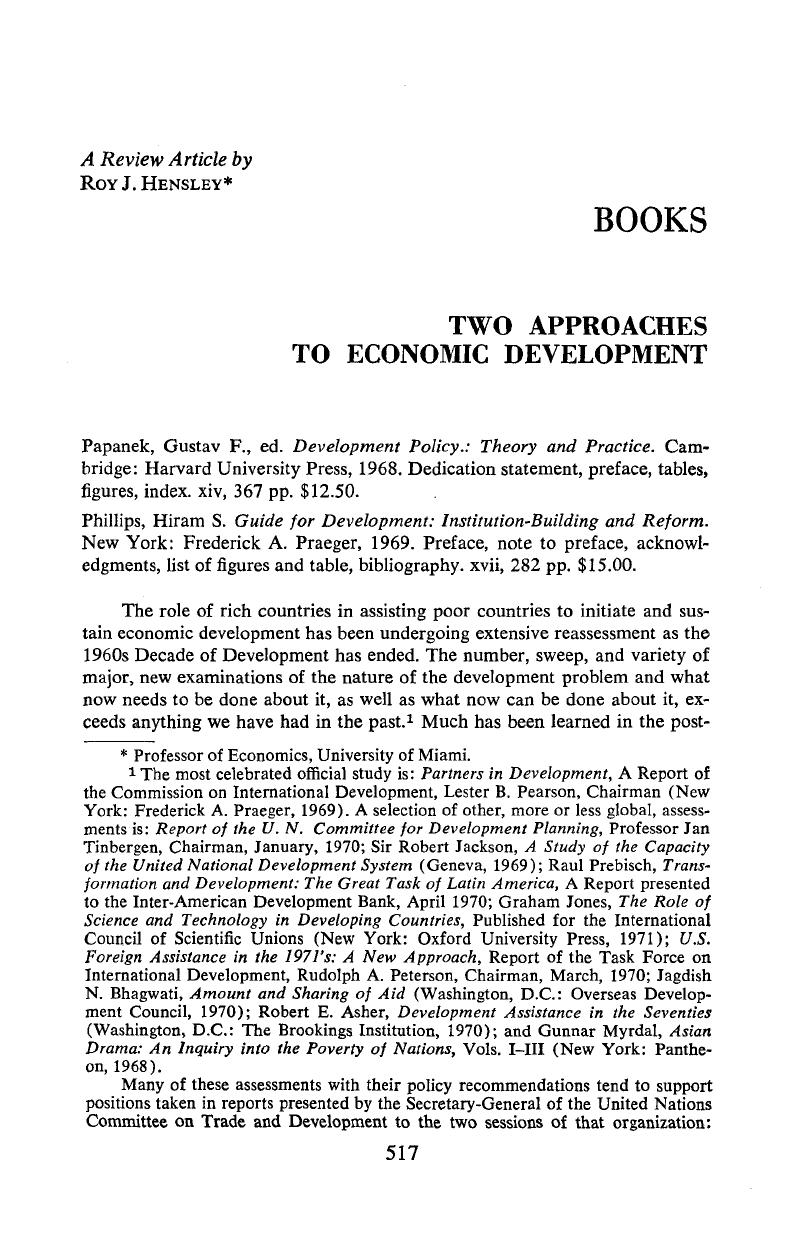No CrossRef data available.
Article contents
Two Approaches to Economic Development
Published online by Cambridge University Press: 02 January 2018
Abstract

- Type
- Books
- Information
- Journal of Interamerican Studies and World Affairs , Volume 13 , Issue 3-4 , October 1971 , pp. 517 - 523
- Copyright
- Copyright © University of Miami 1971
References
1 The most celebrated official study is: Partners in Development, A Report of the Commission on International Development, Pearson, Lester B., Chairman (New York: Frederick A. Praeger, 1969)Google Scholar. A selection of other, more or less global, assessments is: Report of the U. N. Committee for Development Planning, Professor Ian Tinbergen, Chairman, lanuary, 1970; lackson, Sir Robert, A Study of the Capacity of the United National Development System (Geneva, 1969)Google Scholar; Raul Prebisch, Transformation and Development: The Great Task of Latin America, A Report presented to the Inter-American Development Bank, April 1970; Iones, Graham, The Role of Science and Technology in Developing Countries, Published for the International Council of Scientific Unions (New York: Oxford University Press, 1971)Google Scholar; U.S. Foreign Assistance in the 1971's: A New Approach, Report of the Task Force on International Development, Rudolph A. Peterson, Chairman, March, 1970; Bhagwati, lagdish N., Amount and Sharing of Aid (Washington, D.C.: Overseas Development Council, 1970)Google Scholar; Asher, Robert E., Development Assistance in the Seventies (Washington, D.C.: The Brookings Institution, 1970)Google Scholar; and Myrdal, Gunnar, Asian Drama: An Inquiry into the Poverty of Nations, Vols. I—III (New York: Pantheon, 1968)Google Scholar.
Many of these assessments with their policy recommendations tend to support positions taken in reports presented by the Secretary-General of the United Nations Committee on Trade and Development to the two sessions of that organization: Towards a New Trade Policy for Development (1964) and Towards a Global Strategy of Development (1968). For a specific comparison of the Pearson Commission report and UNCTAD proposals see Pollock, David H., “Pearson and UNCTAD: A Comparison,” International Development Review, XII, No. 4, 1970, pp. 14–21 Google Scholar.
2 See the survey articles of Enke, Stephen, “Economists and Development: Rediscovering Old Truths,” Journal of Economic Literature, VII (December, 1969), pp. 1125–1139 Google Scholar, and Bruce Johnston, F., “Agriculture and Structural Transformation in Developing Countries: A Survey of Research,” Ibid., VIII (June, 1970), pp. 369–404 Google Scholar.
3 Adelman, Irma and Cynthia Taft Morris rank 74 countries in terms of 41 social, political, and economic indicators in Society, Politics, & Economic Development: A Quantitative Approach (Baltimore: The Johns Hopkins Press, 1967).Google Scholar
4 Op. cit.,p. 1131.
5 Hagen, Everett E. and Hawrylyshyn, Oli, “Analysis of World Income and Growth, 1955-1965,” Economis Development and Cultural Change, XVIII, No. 1, Part II (October, 1969), pp. 46–48 Google Scholar. Communist less-developed countries grew at 6.3 percent per capita for the first half of the period; data were not available for the second half.
6 Ibid., p. 46.
7 Ibid., pp. 47-48.
8 See Johnston, op. cit., p. 386.




